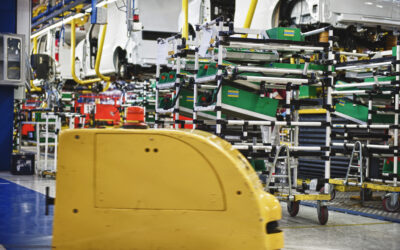Maintenance, Repair, and Overhaul (MRO) operations are the heartbeat of aviation performance, keeping aircraft flying safely and critical equipment running at peak levels.
In an industry where downtime costs millions and safety is paramount, MRO is not optional—it’s essential. But traditional MRO isn’t enough. How these operations are managed determines whether they are a cost burden or a competitive advantage.
In aviation and aerospace, where MRO can account for up to 18% of total operating costs, inefficiencies ripple across an entire organization. That’s why lean MRO principles matter: by eliminating waste, streamlining workflows, and ensuring precise material flow, maintenance operations can evolve from necessary support functions into high-performing drivers of efficiency, safety, and profitability.
What is Lean MRO?
MRO refers to the processes and activities that keep fleets operational—whether it’s maintaining the manufacturing floor or performing regular inspections and repairs on aircraft.
Lean principles focus on eliminating waste, standardizing processes, and ensuring material flow and traceability. When applied to MRO operations, lean thinking focuses less on Just-in-Time (JIT) as you would see in the assembly process and more on minimizing non-value-added steps, part protection, and bottlenecks.
Lean MRO can also bring structure and predictability to environments that often experience reactive maintenance, part shortages, or workflow inefficiencies.
By adopting lean MRO methods, companies can:
- Streamline Maintenance Workflows: Standardized procedures reduce variability and help technicians perform repairs faster and more consistently.
- Reduce Downtime: Quick access to tools, parts, and documentation shortens maintenance cycles.
- Improve Productivity and Quality: Fewer process variations and clearer workflows reduce defects and ensure reliable outcomes.
Lean MRO in the Hanger
Inside your facilities, lean MRO keeps equipment running, prevents unexpected breakdowns, and enhances visual organization and accessibility of tools and parts. Instead of techs wasting time searching for components across long distances, lean methods create an organized, efficient environment.
Visual management systems make tools easy to find and return, while work-in-progress (WIP) racks and kitting carts ensure parts and materials are exactly where they’re needed. For example, specialized kit carts can optimize component flow from a warehouse to each work cell in the hanger. By unboxing parts in the warehouse and delivering them packaging-free to assembly cells, this can reduce scrap, free up work cell space, and improve ergonomics for operators, all while shortening cycle times.
Lean MRO in Aviation and Aerospace
MRO is one of the largest controllable expense categories in aviation and aerospace operations. Efficiency gains in this space translate directly to cost savings and improved asset utilization. We recently partnered with an aerospace client to redesign their maintenance environment using kitting carts. The results were transformative:
- 100% reduction in scrap
- 20% reduction in part defects
- 50% reduction in personnel needs
- 30% increase in productivity
By focusing on ergonomic product movement, safe handling, and structured workflows, we helped the client eliminate waste while enhancing quality and operator safety—a true example of lean MRO in action.
Aerospace MRO operations must also comply with increasingly stringent Federal Aviation Administration (FAA) regulations. The FAA now requires parts to be separated during the MRO process—whether they are waiting to be repaired, replaced, or simply reinstalled after inspection—to prevent damage.
Even small access panels and components must be secured in dedicated kit carts and shadow boards for protection. This focus on safe, organized part handling has made dedicated kitting solutions not just an efficiency improvement, but a compliance requirement.
Common Challenges in MRO Operations
Too many MRO operations accept these inefficiencies without addressing them. Here are some signs your facility should consider adopting lean MRO principles:
#1. Excessive Searching for Parts
Techs often spend significant time searching for the right parts, tools, or documents. This lost time is pure waste and directly impacts uptime. In high-pressure environments like aviation, delays caused by missing parts can have cascading operational and financial effects.
#2. Poor Tool Organization
Unorganized or poorly maintained tool cribs lead to excessive movement and longer repair times. Missing or misplaced tools also increase the likelihood of errors and safety risks.
#3. Inefficient Material Handling
In many MRO settings, parts are delivered or stored far from the point of use. Moving parts repeatedly or carrying them long distances adds unnecessary labor, increases the risk of damage, and contributes to longer turnaround times.
#4. Variability in Processes
Without standardization, every tech may approach tasks differently. This leads to inconsistent quality, longer training times, and difficulty identifying root causes of defects or delays.
#5. Lack of Defect Identification and Mitigation
Reactive maintenance often focuses on repairing after failure, rather than preventing issues before they occur. Without structured processes for early defect detection, minor issues can quickly escalate into costly failures.
#6. Low Customer Satisfaction
In aviation, a delayed aircraft means a delayed customer. Inefficient MRO directly impacts customer satisfaction and can harm long-term business relationships.
Lean MRO Solutions to Overcome Challenges
Geolean provides proven lean solutions tailored to the unique needs of MRO operations. These solutions target key pain points, enabling smoother workflows and more reliable outcomes.
Lineside Storage
- Challenge Addressed: Excessive searching for parts and inefficient material handling.
- Solution: Locating parts and consumables directly at the point of use allows technicians to access everything they need without unnecessary walking or searching.
- Example: An aerospace client can implement modular lineside storage for commonly used parts, reducing walking time and significantly improving turnaround efficiency.
Visual Management
- Challenge Addressed: Poor tool organization and process variability.
- Solution: Visual management tools—such as shadow boards, signage, color-coded tool boards or carts, and standardized work instructions—create a clear, intuitive workspace.
- Example: Implementing visual standards at your maintenance shop can reduce errors due to incorrect tool usage and improve overall safety compliance.
Flow Racks
- Challenge Addressed: Inefficient material handling and poor defect detection.
- Solution: Flow racks keep parts organized, sequenced, and ready for use while improving first-in, first-out (FIFO) handling. This minimizes the use of expired or outdated parts and reduces handling damage.
- Example: A hanger can integrate flow racks at maintenance points and eliminate parts handling time per maintenance job, adding up to hundreds of saved hours per month.
Standardized Material Handling Carts
- Challenge Addressed: Process variation and ergonomic issues.
- Solution: Standardized carts for parts, tools, and kitting ensure that technicians have everything they need in a mobile, organized package. These carts also reduce strain and improve safety.
- Example: An aerospace kitting solution designed for ergonomics and safety can reduce scrap to zero and decrease personnel requirements.
How to Effectively Implement Lean MRO
Implementing lean MRO requires a structured, deliberate approach:
- Assess Your Current State: Map current MRO workflows, identify pain points, and quantify the cost of inefficiencies. Geolean can help by conducting a detailed audit of your maintenance operations. Our team identifies inefficiencies, highlights improvement opportunities, and creates a roadmap for implementing lean MRO solutions.
- Engage Stakeholders: Gain buy-in from technicians, supervisors, and management to ensure alignment and adoption. The most effective way to build support is to come prepared with data and a clear vision—showing how process improvements will save time, reduce frustration, and improve outcomes for everyone. Geolean can help you prepare for these conversations.
- Standardize Processes: Develop clear, documented standard operating procedures and visual aids. This reduces ambiguity and accelerates training for new team members. It also makes it easier to identify and solve problems when they happen because everyone is following the same baseline process.
- Deploy Lean Tools: Geolean USA has installed over 100 designs to aerospace operations and maintains a standardized library of most common solutions. We’ve introduced solutions like lineside storage and standardized carts based on priority impact areas. Whether you need an off-the-shelf solution for rapid deployment or a fully tailored system for complex maintenance requirements, Geolean can deliver solutions that immediately improve efficiency and support your lean MRO goals.
- Measure and Improve Continuously: Use performance metrics such as turnaround time, downtime reduction, and defect rates to track improvements and sustain momentum. Continuous improvement is a core principle of lean MRO; it’s not about one-time fixes but an ongoing commitment to eliminating waste and optimizing performance.
Ready to Transform Your MRO Operations?
Geolean specializes in designing and implementing lean MRO solutions across aviation and aerospace environments. Whether you’re looking to reduce downtime, save space, improve ergonomics, or enhance quality, we provide the tools and knowledge to make it happen.
Don’t wait for inefficiencies to become costly failures. Contact Geolean today and let us show you how our lean MRO expertise can transform your operations, deliver measurable results, and give you a true competitive advantage.



